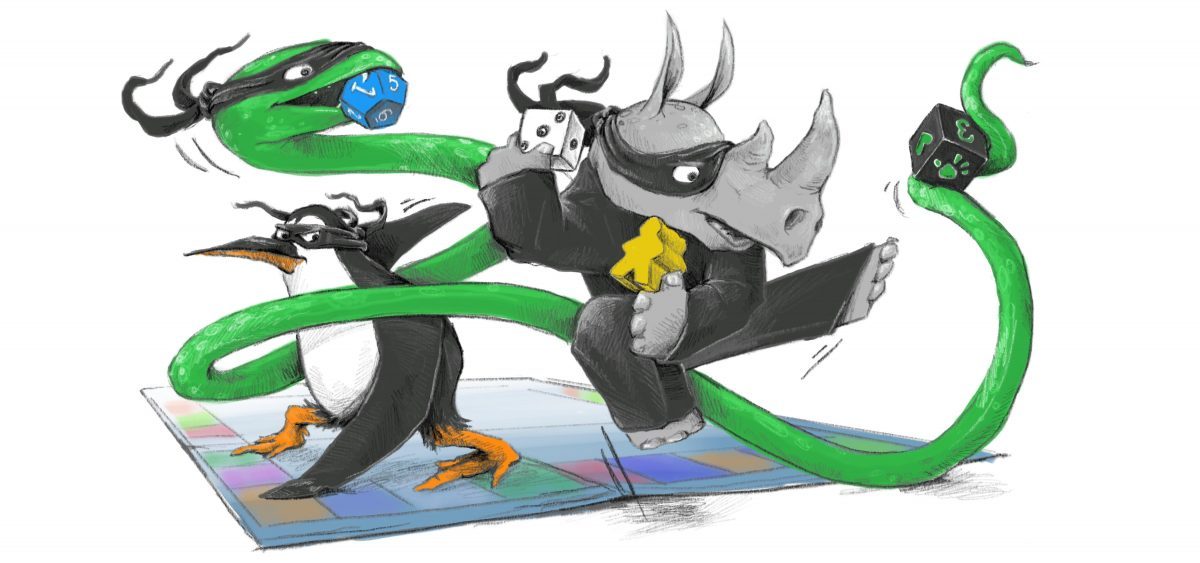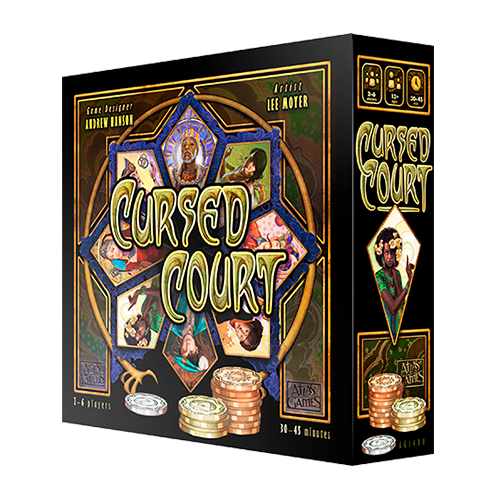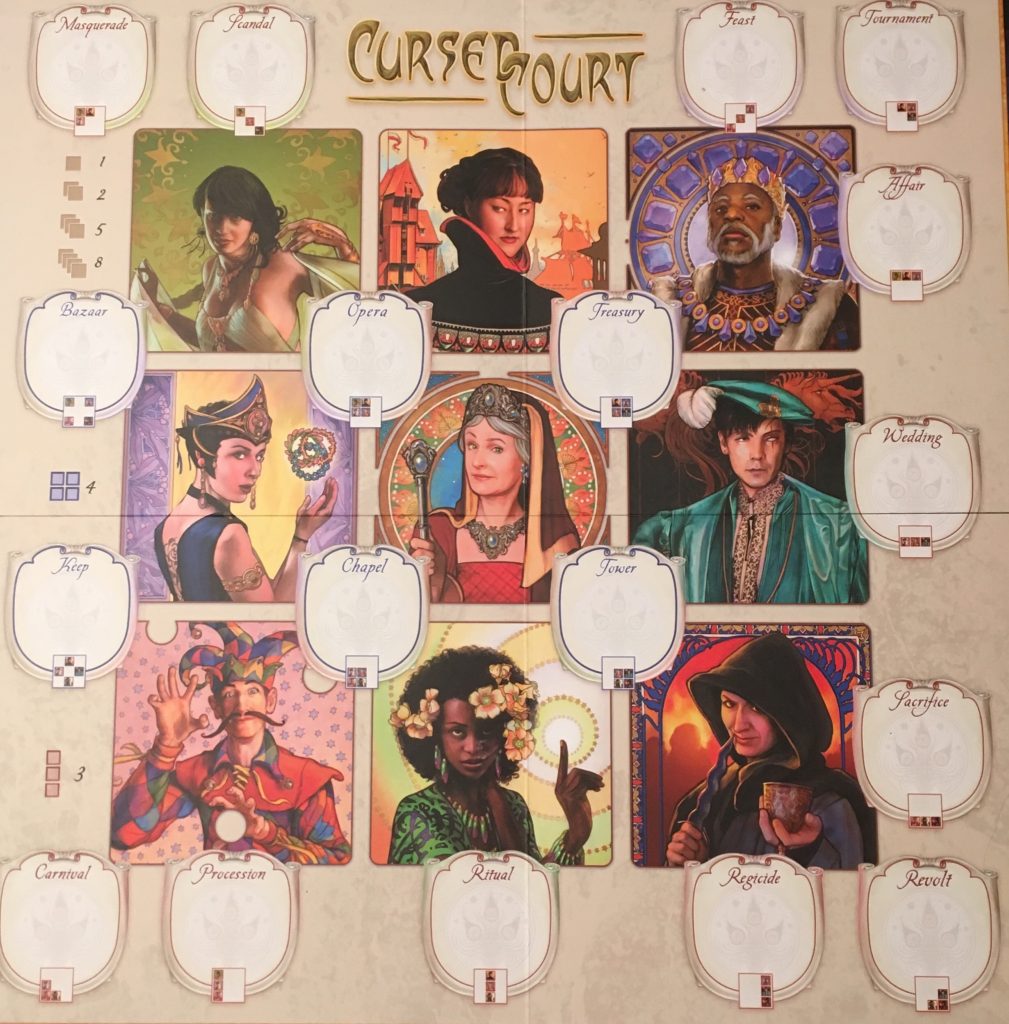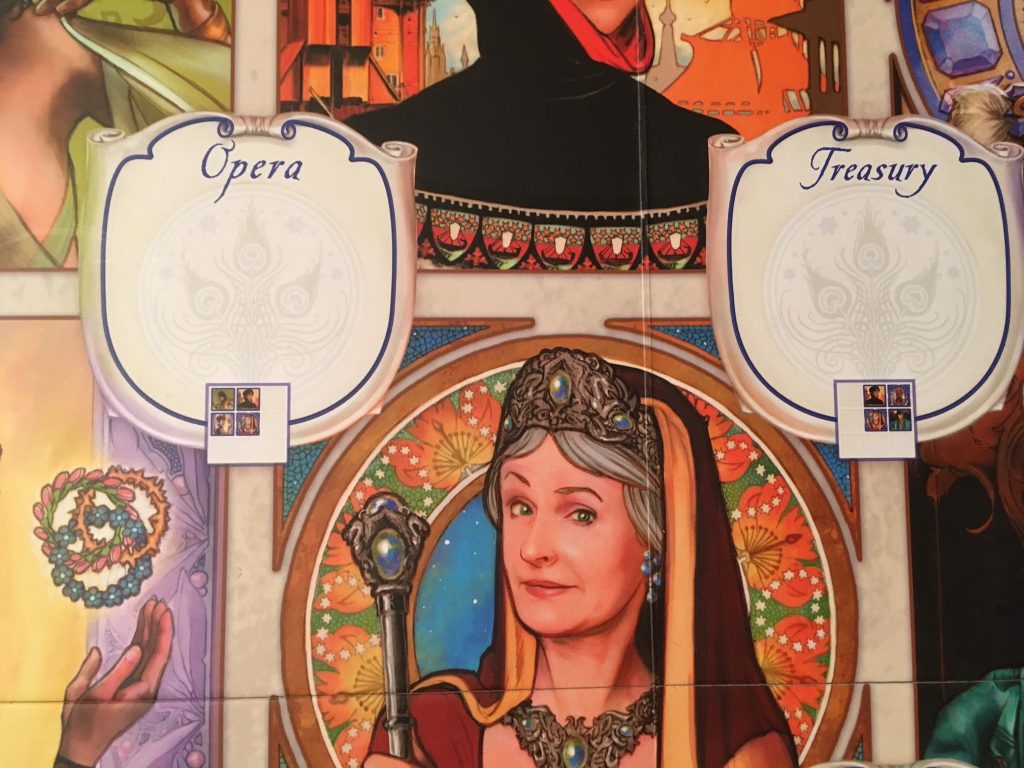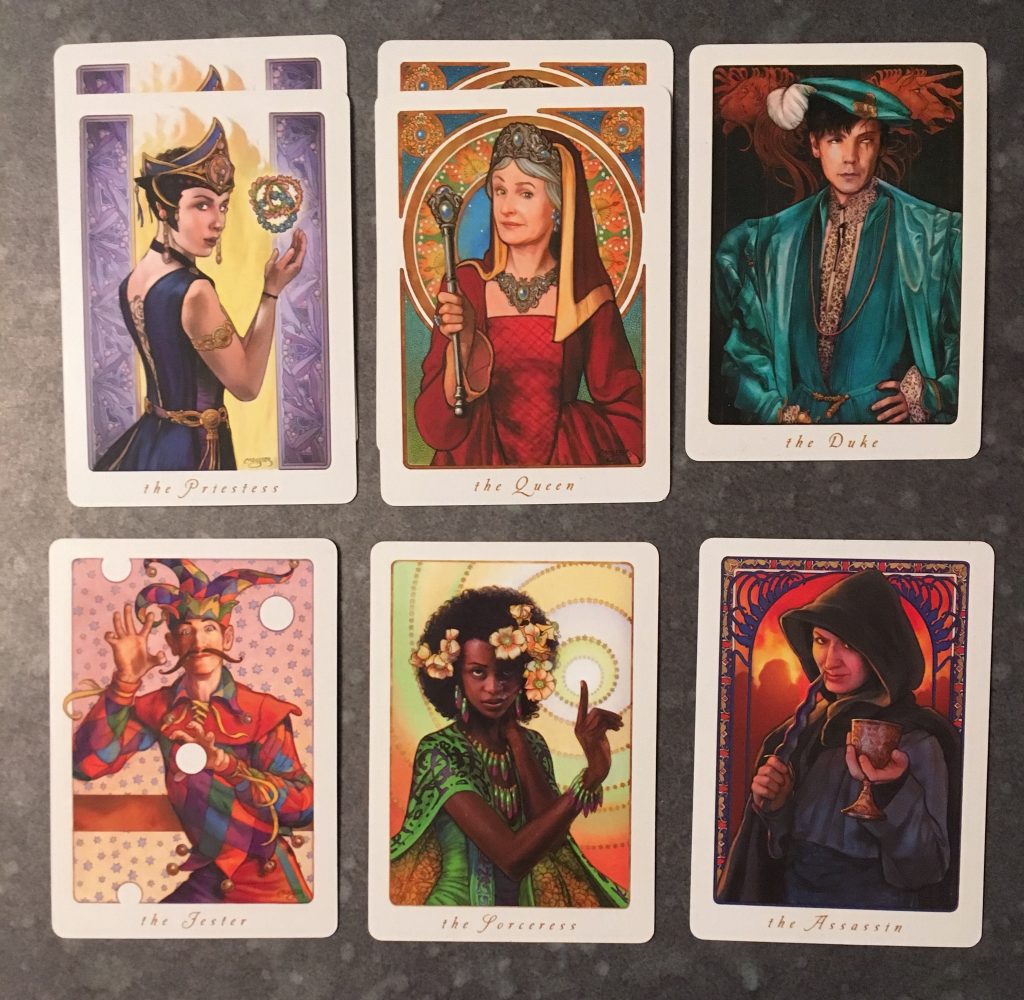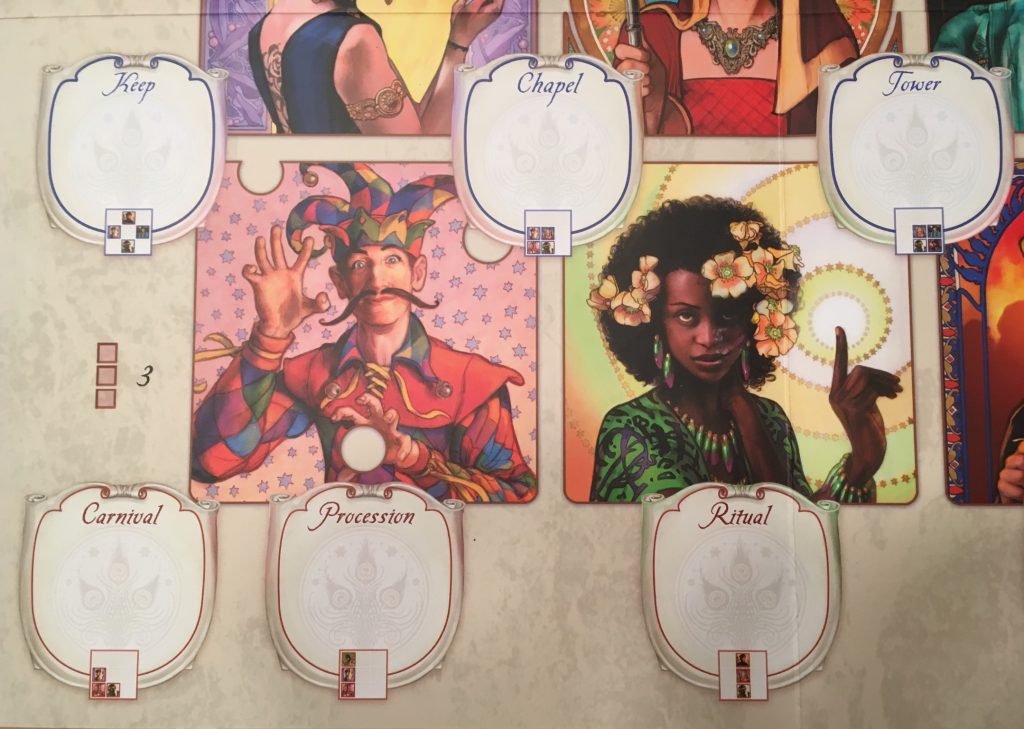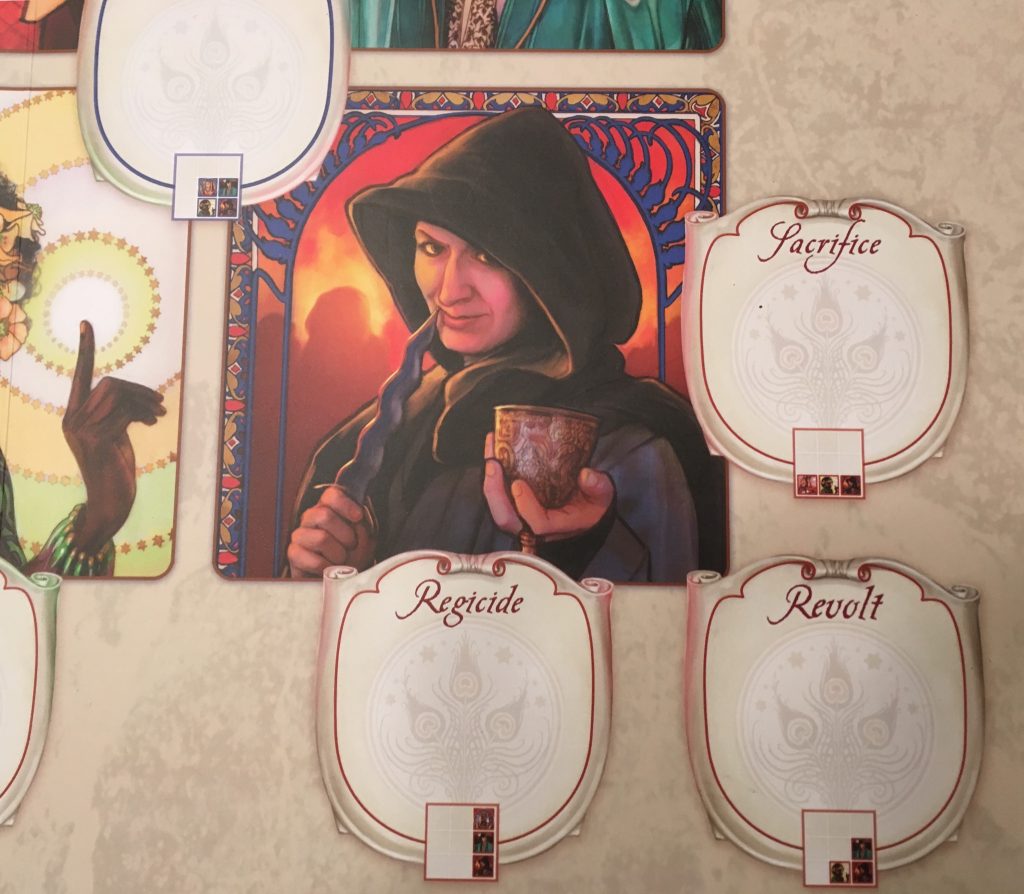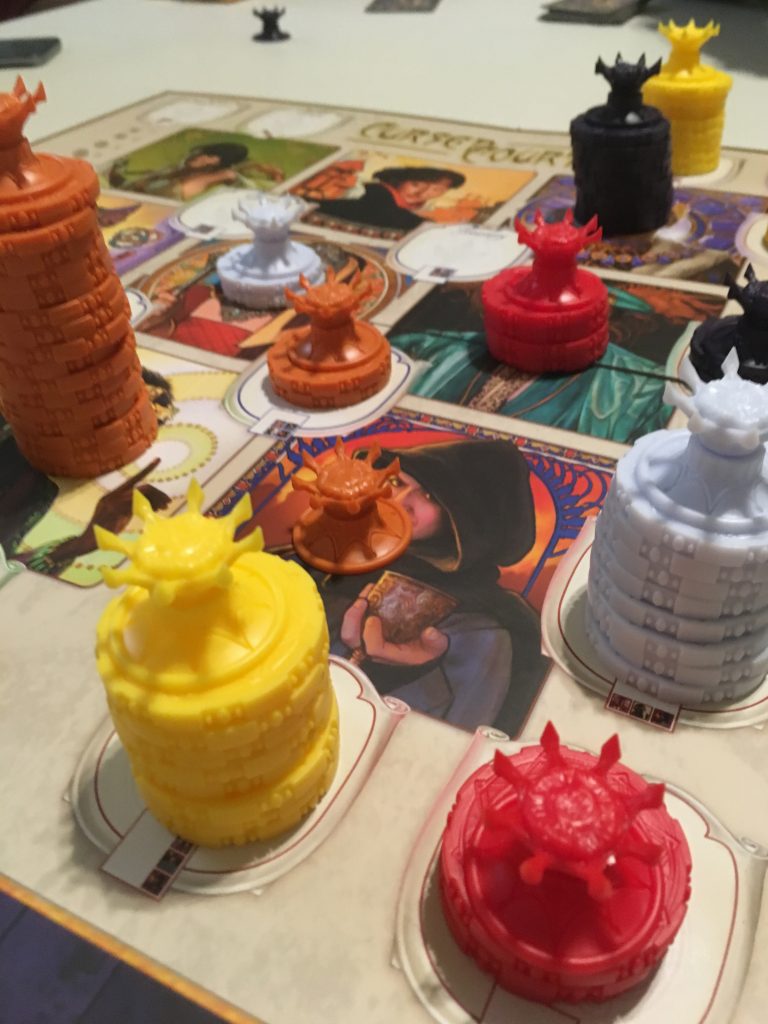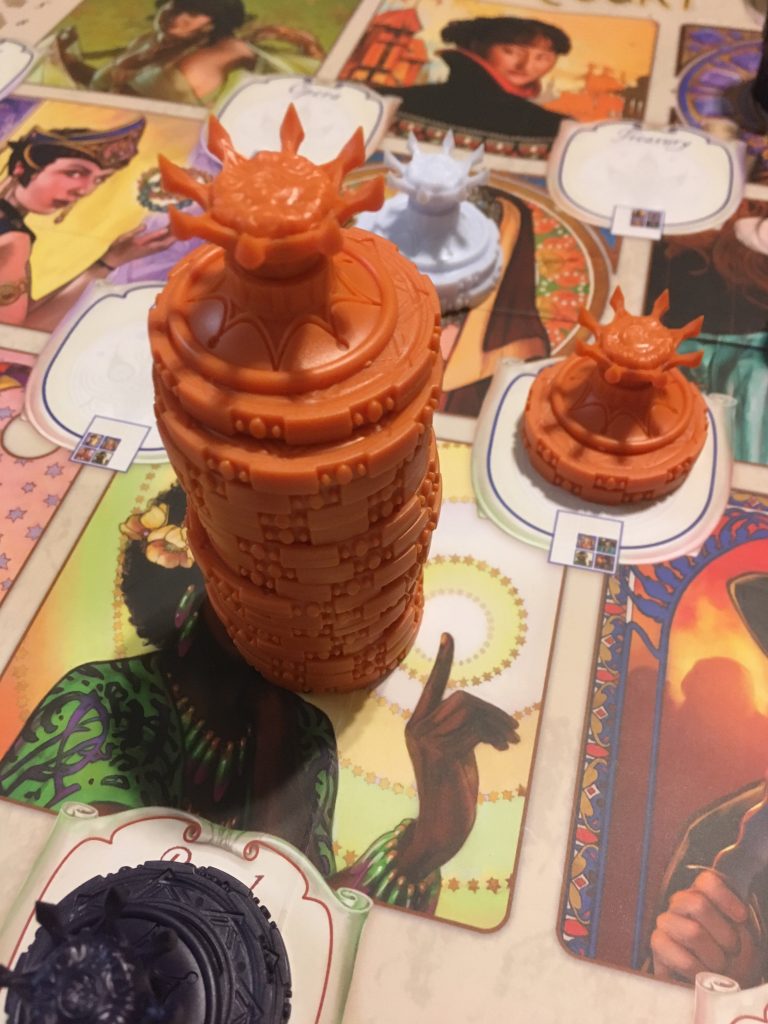Welcome to the Cursed Court. You are a minor noble seeking to wield your limited influence appropriately. To do this you must correctly deduce which of the greater nobles will appear at court and which events will occur during the year. Good Luck!
Cursed Court is at its heart a betting and bluffing game. Everyone has information regarding which members of the court will show up, but only some of the information. So you must deduce based on everyone else’s actions what information they have and how strongly they feel that they are correct.
To really get a handle on the gameplay, you have to understand the scoring. So let’s start at the end of a round and explain how that works.
Example of end round scoring:
At the end of the round you will score points based on where your Crowns are positioned and which Noble cards were dealt out during the round, or Year. The are two types of regions that you can have your crowns occupy at the end of the year. These are Noble regions, which are just the picture of the Noble themselves, and Set regions which are events or locations that are combinations or several nobles.
The Set regions have tiny pictures of the nobles that qualify that region for scoring, but it is the pattern that you are interested in, so don’t get upset that they are too small to make out. For instance, the Affair shows a picture of the top row of nobles, while the Bazaar shows the nobles in all four corners.
So, let’s say for instance if at the end of the round the following cards were present: the Queen (x2), the Priestess (x2), the Duke, the Jester, the Sorceress, and the Assassin.
So the scoring would go like this: Whoever had their crown on the Priestess or the Queen region would score 2 points each, since those nobles appear twice during the year. Whoever had their crowns on the other noble regions would only score 1 point each, since the nobles only appeared once during the year. In addition because the Priestess, Queen and Duke all appeared, then whoever had their crown on the Wedding would score 3 points. Since the Jester, Sorceress and Assassin all appeared, then whoever had their crown on the Sacrifice would score 3 points.
The same is true for the Carnival, and the Revolt. Anyone with their crowns on the Tower, or the Chapel would also score, but this time 4 points since 4 nobles were present at those locations.
If you had bet on the Regicide region because you knew the Assassin and the Duke were present, but were just guessing about the King, you would not score any points. An educational guess, and a good one, but since the King did not show up all year, no points are scored for Regicide (thank goodness for the King).
So now that we know about the scoring, how do we play?
To start with, everyone will have a card dealt in between them and the player on either side of them. So from the beginning of the Year, you will know 2 of the cards that will be present at the end of the Year. In addition, at the beginning of each of the 4 seasons, a card will be dealt to the side of the game board, giving everyone knowledge of a third card, then a fourth, fifth and sixth card. Based on this knowledge, you will try to guess, bluff, deduce and outmaneuver your opponents to lay claim to the correct spaces on the board. Each round you will know a little bit more, but so will everyone else.
Now that you have information, you make a bet. Let’s say you have the King between you and the player to your left, and the Courtesan between you and the player to your right. When the first card is dealt face up for everyone to see, it is the Merchant. Now you have concrete knowledge that the Affair region is going to pay off for 3 points at the end of the year. You also know that each of the 3 characters you have seen so far will appear. So, it would be good for you to place your crown on either the King, Courtesan, Merchant or Affair. But some of those spots are already occupied by other players’ crowns. So what do you do? No worries, you can bump their crowns off, you just need to bet more than they did.
Let’s stop for a minute and talk about how betting works. If you simply place your crown down on a region with no coins under it, you have bet 0 coins, with 7 under it, you have bet 7 coins. Each player has 20 coins, so your resources are limited. (Luckily you get them back between each of the 3 years the game is played). In order to bump someone else’s bet, you must double it. For example if I place my crown on the Opera region because I have seen the Priestess, Queen and Merchant, I might place 4 coins under it. I am hopeful that the last noble needed, the Courtesan will show up by the end of the year. Then one of my opponents, based on information that they have decides that they want to bet on the Opera region instead. In order to do so, they must bet at least 8 coins. If they only had 7 left, then they could not bump my crown off of the region. In order to bump someone with no coins under their crown, you must spend at least 1 coin. Also, a bet of 11 cannot be doubled, so if you are certain about a region, you can lock it in early, but it hampers your betting, so be careful. Here, the orange player really thinks the Sorceress will show up multiple times:
If someone does bump you off of your region, you will get to place that crown again before the end of the season. You can place it on a new region, or outbid the player who just bumped you and take back your spot. Once all players have placed their crown for the season, you deal a new community card face up and move on to betting for the next season.
Each year, you will be placing all 4 of your crowns on different regions of the board, either Noble regions or Set regions. Even if some of your crowns do not have any coins strengthening your bet, they would still pay off at the end of they year. This is very likely to happen, since your coin pool is limited.
So, after everyone has bet all of the crowns, you flip all of the cards that were in between players and start paying off regions in points. At the end of 3 years, whoever has the most points is the winner.
So what do we think?
Let’s start with the components. They are all very nice, especially the artwork on the board and the cards. All of the characters are very diverse, which is always nice to see and hardly ever a focus, but it clearly was with this game. The chips are basically different colored poker chips,but they have a nice heft to them. The crowns are great, but they are deadly sharp. I mean, seriously they have now taken the place of Legos as the thing I want to step on least.
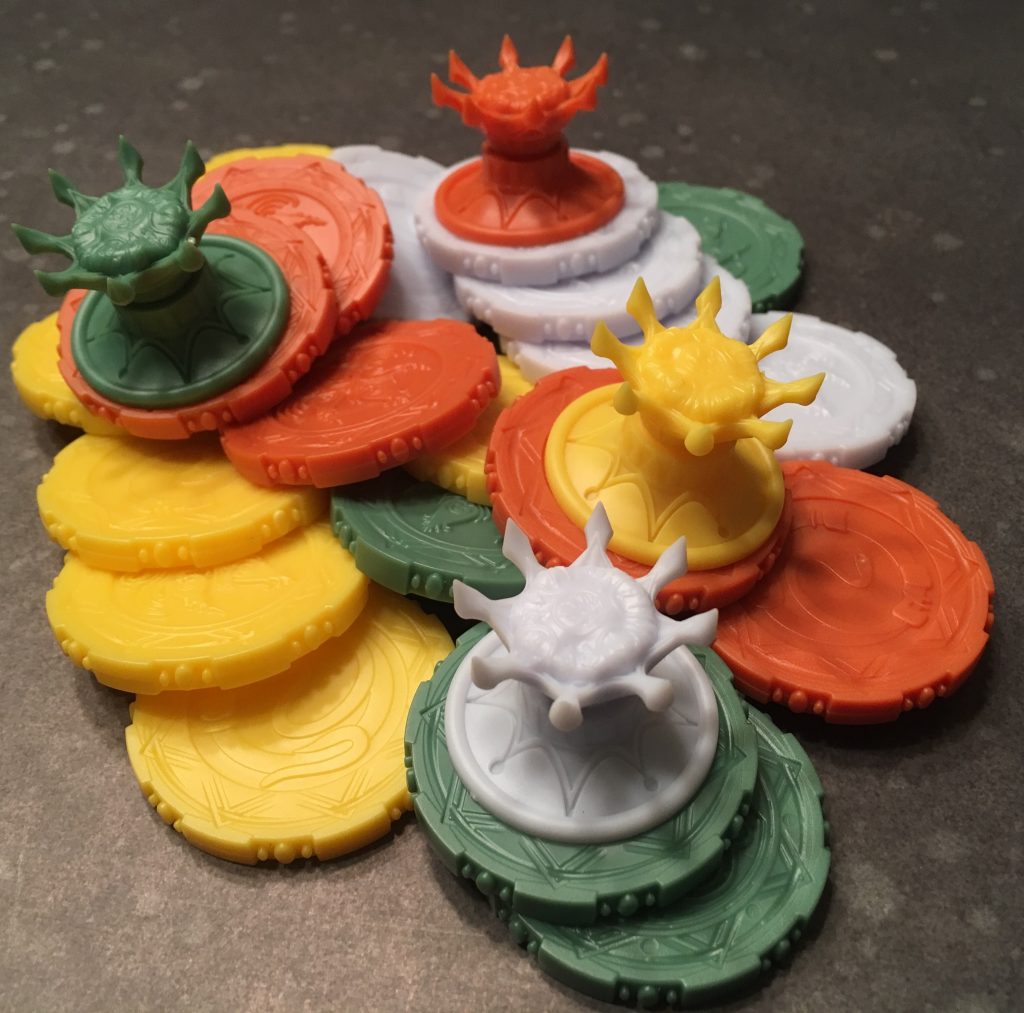
All very cool. Also in case you didn’t notice, the Queen is Bea Arthur.
But the strength of the game is the gameplay so let’s look at that.
One of the coolest things about the game is the flow of information – when someone bets strongly on a character you assume they have knowledge about that character that you don’t – this can influence your bets even if the other player was working off of information they assumed from other people’s actions. These types of assumptions and deductions can greatly alter the game.
We spend the entire year assuming that someone had seen the Jester because they bet heavily on the left column early on, but it turned out they had seen the other two characters and were making an educated guess. Even so, it influenced the rest of the round, and the outcome of the game.
Once you understand the rules, gameplay goes really quickly. There is the possibility of someone getting stuck due to AP, but most of the time players have a decent idea as to where they are going to play ahead of time. This is great until someone claims the region that you wanted. But don’t fret, you can always just outbid them, if you have the chips. Also, since the board is in constant flux, everyone pretty much pays attention too, which at least feels like less downtime.
The 4 community cards that are revealed throughout the year really change things as well. If they are 4 different cards, they can cause a run on certain Set regions, but if 3 of them were the Duke, then that would make his space highly contested. Less information overall, but 5 points guaranteed for someone.
Cursed Court has a very light feel and was a good closing game for my group. We had tried some longer heavier games earlier in the night the first time we played it and it was a nice cool down game. I’m not saying it doesn’t stand in its own, it’s just not the sort of game that I’m going to play for hours and hours at a time. For me, playing through the three year cycle is just perfect. It gives you just enough of the game without wearing out its welcome. It’s just thinky enough, without causing me to spend tons of brain power. Reading other people’s reactions to bets, waiting for new community cards, and outbidding each other also causes just the right amount of table talk.
As far as player counts go, I probably wouldn’t try it at less than four players. Five and six were really the best, and since it goes fast, especially once you’ve played it a couple of times, the extra players won’t slow it down. I never felt like I was waiting around for my turn, and for me that is always important
If you like betting and bluffing or basically Poker, give this one a try, you won’t be disappointed. We had a good time every time it hit the table and I think you will too.
Ninja Approved.
Atlas Games sent us Cursed Court in exchange for an honest review which is what we provided.
